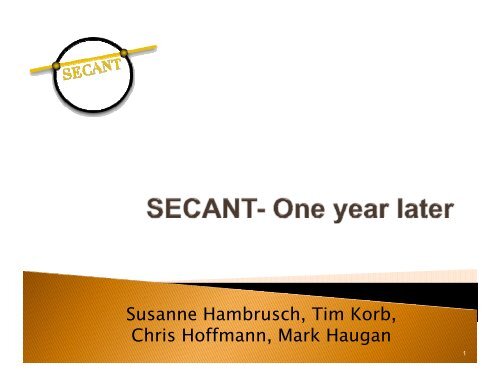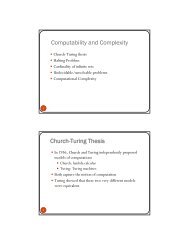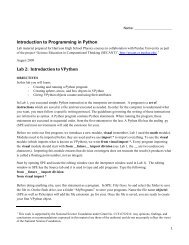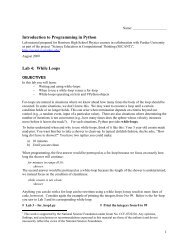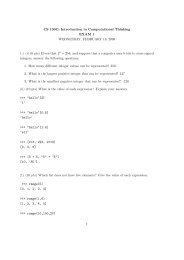Susanne Hambrusch Tim Korb Susanne Hambrusch, Tim Korb ...
Susanne Hambrusch Tim Korb Susanne Hambrusch, Tim Korb ...
Susanne Hambrusch Tim Korb Susanne Hambrusch, Tim Korb ...
Create successful ePaper yourself
Turn your PDF publications into a flip-book with our unique Google optimized e-Paper software.
<strong>Susanne</strong> <strong>Hambrusch</strong>, <strong>Tim</strong> <strong>Korb</strong>,<br />
Chris Hoffmann, Mark Haugan<br />
1
Purdue science majors have a computing<br />
requirement<br />
Currently they can choose among four CS<br />
courses<br />
A first course should<br />
◦ Teach computational thinking and problem<br />
solving skills<br />
◦ Increase the interest in computing<br />
◦ Promote computational scientific inquiry<br />
2
Physics<br />
• Currently using VPython in an introductory t physics<br />
course<br />
• Faculty are interested t din students t gaining i a more<br />
complete understanding of computation<br />
Chemistry<br />
• Learn computational methods relevant in chemical<br />
hi ti l MCSA<br />
research, in particular MC, SA<br />
• Be able to use and run existing programs (e.g., written<br />
in Fortran)<br />
3
Bioinformatics and Statistics<br />
Teach R for statistical computing and<br />
visualization<br />
Use a language for which bioinformatics<br />
software packages exist or can be integrated<br />
4
Lay the groundwork for computational<br />
thinking<br />
Programming language should allow a<br />
focus on computational principles<br />
Present examples in a language familiar to<br />
the students<br />
Teach in a problem-driven way<br />
Make effective use of visualization<br />
5
6 weeks on programming basics in Python<br />
6 weeks on computational tools and methods<br />
◦ Numerical issues<br />
◦ Introduction to simulation and Monte Carlo methods<br />
◦ Guest lectures in Physics and Bioinformatics<br />
◦ Scientific visualization<br />
◦ Grand challenges<br />
3 weeks on important CS material<br />
◦ Object-oriented design<br />
◦ History of computing<br />
◦ Limits of computation, future models<br />
Format: 2 lectures per week, one 2-hour lab<br />
6
Python<br />
VPython<br />
NumPy<br />
PyLab from MatPlotLib<br />
NetworkX<br />
Cytoscape<br />
7
Four projects<br />
◦ Manipulating Digital Audio<br />
◦ Percolation in Grids<br />
◦ Simulating Physical Systems<br />
◦ Analyzing Protein-Protein Interactions<br />
Each project had a<br />
◦ programming component<br />
◦ experimental component (with a write-up)<br />
◦ http://secant.cs.purdue.edu/cs190c:projects<br />
8
Explore the generation and manipulation of digital sound<br />
Students t implemented several basic functions explored<br />
new operations<br />
Array operations, loop structures, numerical issues, and<br />
listen to sound and visualize waves<br />
Feedback<br />
◦ Challenging for some to get started<br />
t ◦ Enjoyed the flexibility and creativity the project allowed<br />
◦ Most recognized later that it was an easy project and a<br />
great learning experience<br />
9
Modeled after the chapter on percolation in the<br />
Sedgewick-Wayne text<br />
Two-dimensional structures, recursion, random number<br />
generation<br />
VPython visualization and plotting graphs during the<br />
computation<br />
Feedback<br />
◦ For many, this was the favorite project<br />
◦ Nice combination of visualizing progress during the<br />
computation ti and generating plots visualizing i the<br />
results<br />
10
Use the Monte Carlo “demon algorithm” to estimate<br />
parameters in physical system<br />
◦ an ideal gas with moving molecules<br />
◦ Ising Spin model<br />
Adapt a generic Demon Algorithm specification i to each<br />
simulation, run fairly large the simulations, generate<br />
various plots and histograms from generated data<br />
Feedback<br />
◦ Seemed natural material for physics and chemistry<br />
majors<br />
◦ Physics lectures were crucial for understanding and<br />
motivation<br />
11
Use data sets from large-scale experiments<br />
characterizing i protein-protein t i interactions ti in S.<br />
cerevisiae (baker’s yeast) to generate graphs<br />
Apply graph operations using NetworkX and a<br />
provided clustering routine (MCL) to “clean” graph<br />
and determine clusters<br />
Graph visualization using Cytoscape<br />
Evaluate the quality of the clustering by using<br />
biological information obtained from the Gene<br />
Ontology (GO)<br />
12
Students found abstraction using graphs<br />
challenging<br />
There were no biology students in the class to<br />
“spread” excitement<br />
Graph visualization provided NetworkX does not<br />
scale; students switched to Cytoscape too late<br />
Project would be easier with more class<br />
preparation<br />
Most research-oriented project<br />
13
Python strengths…<br />
◦ Low-syntactic overhead<br />
◦ Rich primitives and built-ins<br />
◦ Straightforward 3D visualization (with VPython)<br />
Python weaknesses…<br />
◦ Successful transition to C/C++ and Java unclear<br />
◦ Larger programs can be more difficult<br />
• No compile-time type checking<br />
• Testing crucial for, e.g., library use<br />
14
Delayed “programming in the large” concepts<br />
Focused on techniques needed to solve problems<br />
◦ Many declarations not needed (or not available)<br />
◦ Used built-in i and library functions where possible<br />
◦ Introduced abstractions (declarations, functions, classes)<br />
when motivated<br />
Concepts needed to understand what’s going on…<br />
◦ Audio sampling -> binary representation<br />
◦ Performance -> cost of some primitives iti (e.g., max(array))<br />
◦ Parameter passing and side effects -> the heap<br />
◦ Recursion -> the runtime stack<br />
15
Visualization is important<br />
◦ For learning how to solve problems<br />
◦ For understanding what is computed<br />
◦ For finding bugs<br />
2D graphing is fine, but 3D is better –<br />
◦ Especially when you can interact immediately<br />
Bad random number example:<br />
r k+1 = (65539*r k + 12345) % 32767<br />
16
Information visualization tools are in infancy:<br />
◦ Graph layouts, data structures, etc require considerable<br />
programming effort and are cumbersome to use<br />
For 3D, viewing interactions are challenging:<br />
◦ Managing camera, frustum and illumination can be tricky<br />
◦ Direct manipulation interfaces an issue<br />
Scaling issues:<br />
◦ Viewing large data, viewing at high resolution<br />
17
Impact on Science Disciplines: Physics<br />
Impact on students<br />
Physics students gain<br />
◦ a healthy new perspective on the nature of and<br />
interplay between physics and (applied) mathematics<br />
by solving realistic problems computationally<br />
ti ◦ computational knowledge and skills that create new<br />
opportunities for learning and research in our<br />
department<br />
Challenges<br />
◦ overcoming a resistance to computing evinced by some<br />
of our students so that more of them realize the gains<br />
18
Impact on faculty and our science<br />
Physics faculty gain<br />
◦ students with new resources for learning in the<br />
classroom and the lab<br />
◦ students prepared for undergraduate research in the<br />
expanding field of computational physics<br />
p g p p y<br />
Challenges<br />
◦ increasing faculty awareness of the resources above,<br />
especially as it relates to revising classroom and lab<br />
instruction to take advantage of them [NB. Phys 344]
15 students, 2/3 were freshmen<br />
Physics and Chemistry majors, some Math double<br />
majors<br />
For the freshmen, the course satisfied the College<br />
of Science computing requirement<br />
About ¾ had some prior programming experience<br />
High-ability students<br />
◦ Clearly among the 30% of the freshmen completing a<br />
degree in science<br />
20
Two questions from the survey<br />
How would you rate your current interest in:<br />
Taking another computer science course?<br />
Pursuing a career that requires programming<br />
skills?<br />
0: not interested, 1: somewhat uninterested<br />
2: undecided, 3: interested, 4: very interested<br />
21
Interest in<br />
taking<br />
another CS<br />
course<br />
Students<br />
Interest in a<br />
career that<br />
requires<br />
programming<br />
0<br />
1 3 2 4
In our usual introductory programming courses,<br />
interest in computing decreases; echoed in<br />
other studies<br />
In 190C, interest increased<br />
◦ Half the students plan to minor in CS<br />
◦ Students realize that computational skills make<br />
them more competitive for internships<br />
◦ 2 students are currently REUs in CS<br />
◦ One student is thinking about becoming a CS<br />
major<br />
24
The problem-driven format and quickly writing<br />
meaningful programs increases student interest.<br />
Python is an excellent language vehicle.<br />
Visualization is an important component and brings<br />
many quantitative scientific facts to life.<br />
Interaction with science faculty is critical to designing<br />
g<br />
an effective course.<br />
Getting institutional buy-in should not be<br />
underestimated.<br />
25
What comes after the first course?<br />
◦ Planning a second course in which CS and science<br />
students collaborate in teams<br />
◦ Provide REU opportunities<br />
◦ Get Physics students involved in the use of Python in the<br />
Physics courses<br />
Should different versions of the course be taught<br />
to different majors?<br />
◦ We believe that the same first course can serve all science<br />
disciplines well<br />
◦ Motivation of domain specific projects needs consideration<br />
26
Make the first course a regular course<br />
Work with science departments<br />
◦ understand d how the material relates to other<br />
courses<br />
◦ Give advice on effectively integrating<br />
computation into their later courses<br />
27
Lennard-Jones simulation using Simulated<br />
Annealing<br />
Using Scribbles Robots (obstacle avoidance,<br />
driving on roads)<br />
Spread of disease simulation<br />
Better visualization for large graphs<br />
28


